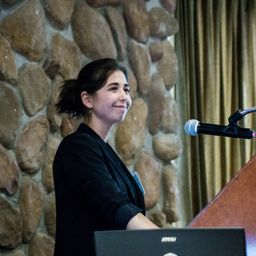Impact du changement de classe des médiateurs lipidiques bioactifs
Mon statut pour la session
Partie de:
Quand:
11:30 AM, Lundi 23 Nov 2020
(1 heure)
Où:
Session virtuelle
Cette session est dans le passé.
L'espace virtuel est fermé.
Impact of bioactive lipid mediator class switching on myogenesis and skeletal muscle function.
Paul Fabre1,2, Thomas Molina1,2, Zakaria Orfi1,2, Junio Dort1,2, Talita Conte1,2 and Nicolas A. Dumont1,2
1-CHU Sainte Justine, 2-Université de Montréal
The skeletal muscle formation during prenatal development, post-natal growth or regeneration is ensured by muscle stem cells. The myogenesis process is highly regulated and characterized by the activation of quiescent muscle stem cells, which become proliferating myoblasts that eventually exit the cell cycle to self-renew or to differentiate and fuse to form myotubes. However, the mechanisms regulating muscle stem cells progression during myogenesis are still elusive. Recent studies have shown that the cell fate decision of different stem cell types is regulated by lipid mediator class switching, an auto-regulatory mechanism during which poly-unsaturated fatty acids, beforehand transformed into pro-inflammatory lipid mediators, are replaced by pro-resolving mediators. This substitution is the consequence of a switch in the enzymatic profile, leading to the replacement of pro-inflammatory enzymes Cyclooxygenase-2 (COX-2) or 5-lipoxygenase (Alox5) by anti-inflammatory enzymes, 12- and 15- lipoxygenase (Alox12, Alox15). Here, we hypothesize that bioactive lipid class switching is a key regulator of myogenesis progression. Our qPCR and western blot experiments indicate that myogenic cells express the enzymes responsible for bioactive lipids biosynthesis as well as their receptors. Furthermore, our in vitro analysis shows that the enzymatic switch occurs when myoblasts exit the cell cycle to differentiate. Using mice deficient in the different bioactive lipid enzymes our in vivo experiments have demonstrated that a lack of those enzymes impairs normal myogenesis. In summary, our study will provide a better comprehension of the mechanisms regulating muscle stem cells during myogenesis, which could open new therapeutic avenues for skeletal muscle growth and regeneration.





